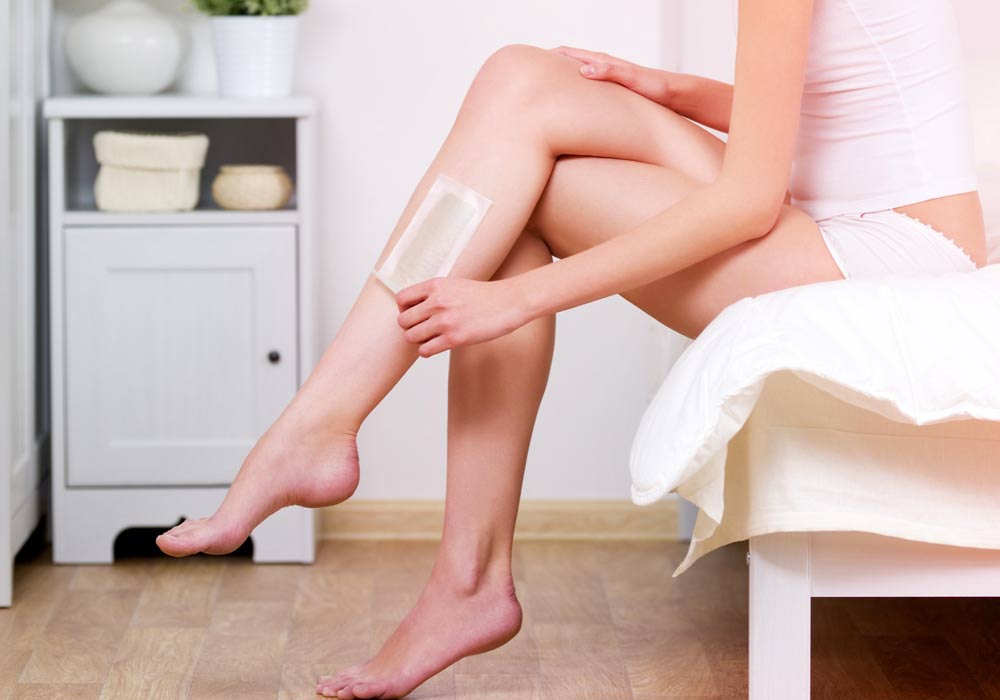For many people, leg hair is an unwelcome annoyance that seems to grow back almost as soon as it’s been removed. But have you ever wondered why your leg hair grows so fast? It turns out that there are several factors that contribute to the speed at which leg hair grows, from genetics to hormones to lifestyle choices.
In this article, we’ll explore why some people’s leg hair grows faster than others, and what you can do to slow down the growth of your leg hair.

- Biology of Hair Growth
- Hormones and Fast Hair Growth
- Genetics and Hair Growth
- Age and Fast Hair Growth
- Nutritional Factors
- Environmental Factors for Faster Hair Growth
- Health Conditions and Medications
- Hair Removal Techniques
- Tips for Managing Fast-Growing Leg Hair
- How Do You Get Rid of Leg Hair Naturally?
- Self-Acceptance
- How Do I Stop My Leg Hair From Growing Back So Fast?
- Conclusion
Biology of Hair Growth
Hair growth is a natural process that occurs in cycles. The three main stages of hair growth are the anagen phase (active growth phase), catagen phase (transition phase), and telogen phase (resting phase).
During the anagen phase, hair cells divide rapidly, and hair grows actively from the hair follicle. This phase typically lasts between 2-7 years and can be affected by factors such as age, genetics, hormones, and nutrition.
After the anagen phase, hair enters the catagen phase, which is a brief transition phase that lasts for about 2-3 weeks. During this phase, the hair follicle shrinks, and the hair stops growing.
Finally, the hair enters the telogen phase, which is the resting phase that lasts for about 3-4 months. During this phase, the hair follicle is at rest, and the hair is no longer growing. At the end of the telogen phase, the old hair falls out, and the cycle starts over again with the growth of new hair.
Hormones and Fast Hair Growth
Hormones play a significant role in hair growth, as they can affect the growth cycle of hair follicles. Androgens, a group of hormones that includes testosterone, can stimulate hair growth, while estrogen can slow it down. This is why men typically have more body hair than women, as they have higher levels of androgens.
Hormonal changes during puberty, pregnancy, and menopause can also affect hair growth, leading to changes in thickness, texture, and color. Additionally, hormonal imbalances or disorders can cause excessive hair growth in unwanted areas, such as the face or chest, a condition known as hirsutism.
Understanding the relationship between hormones and hair growth can help individuals better manage and address their hair concerns.
Tight clothing can cause friction against your skin, leading to ingrown hairs and irritation. Similarly, excessive sweating can lead to clogged pores, leading to the formation of ingrown hairs. Avoid wearing tight clothing immediately after shaving and opt for loose, breathable fabrics instead.
Genetics and Hair Growth
Genetics can play a role in how fast hair grows by determining the length of the hair growth cycle, the number of hair follicles, and the rate of cell division within the follicles. Hair growth is a complex process that is regulated by a variety of genes that can vary between individuals.
Some people may have genetic variations that promote faster hair growth, while others may have genetic variations that slow down the growth cycle.
When it comes to leg hair specifically, genetics can also play a role in determining the density and thickness of the hair follicles on the legs. For example, some people may have a greater number of hair follicles on their legs, which can result in faster hair growth. Additionally, hormonal imbalances can also affect hair growth on the legs, and these imbalances can also be influenced by genetics.
Also Read: Why Does My Hair Curl at the End? (With Solutions)
Age and Fast Hair Growth
Age can have a significant impact on hair growth, as the rate of hair growth tends to slow down as we get older. This is because the hair growth cycle becomes shorter and the number of active hair follicles decreases with age. The thickness and density of hair may also change, with hair becoming thinner and more brittle over time.
However, when it comes to leg hair specifically, some people may experience faster hair growth as they get older. This is due to changes in hormone levels that occur with age. In women, the decline in estrogen levels during menopause can lead to an increase in androgen hormones, which can stimulate hair growth on the legs and other areas of the body.
Overall, while age can generally lead to slower hair growth, changes in hormone levels and other factors can also affect hair growth on specific areas of the body, such as the legs.
Nutritional Factors
A diet that is rich in vitamins, minerals, and other essential nutrients can help to promote strong, healthy hair by supporting the growth and maintenance of hair follicles. One key nutrient that is essential for healthy hair growth is protein.
Another important nutrient for healthy hair growth is iron. Iron helps to carry oxygen to the hair follicles, which is necessary for hair growth. Foods that are rich in iron include red meat, spinach, beans, and fortified cereals.
Vitamin C is also essential for healthy hair growth, as it helps the body to produce collagen, which is important for hair strength and elasticity.
A balanced and nutritious diet that is rich in protein, iron, vitamin C, and other essential nutrients can support healthy hair growth, including on the legs.
Environmental Factors for Faster Hair Growth
Environmental factors such as temperature and humidity can also affect hair growth on different parts of the body. For example, hair may grow faster in warmer, more humid environments, as the increased moisture can help keep hair hydrated and healthy.
Temperature changes can affect hair growth on the legs, as cold temperatures can slow down blood circulation and reduce nutrient delivery to the hair follicles. On the other hand, high temperatures can increase blood flow and stimulate hair growth.
Health Conditions and Medications
Certain health conditions and medications can have an impact on hair growth and may contribute to faster-growing leg hair in some individuals. Here are some examples:
- Hormonal conditions: Hormonal imbalances, such as those that occur with polycystic ovary syndrome (PCOS), can cause excess hair growth on the legs and other parts of the body. This is because hormones such as testosterone can stimulate hair growth in areas that are not typically associated with hair growth.
- Thyroid conditions: An underactive or overactive thyroid gland can affect the hair growth cycle, leading to hair loss or slower hair growth. In some cases, however, thyroid conditions can cause excess hair growth on the legs and other parts of the body.
- Medications: Certain medications can affect hair growth, either by stimulating it or inhibiting it. For example, some medications used to treat cancer or autoimmune diseases can cause hair loss, while others may stimulate hair growth. In some cases, medications such as birth control pills may cause excess hair growth on the legs and other parts of the body.
Hair Removal Techniques
Different hair removal techniques can have varying effects on hair growth on the legs. Here are some examples:
- Shaving: Shaving is a common method of hair removal on the legs, but it does not affect hair growth itself. Shaving only removes the hair above the skin surface, so hair will continue to grow at its normal rate. However, shaving can make hair appear thicker or darker as it grows back, as the sharp end of the hair follicle is exposed.
- Waxing: Waxing involves removing hair from the root, which can cause hair to grow back more slowly and finer. Over time, regular waxing may lead to a reduction in the amount of hair that grows on the legs. However, the hair that does grow back may be more prone to ingrown hairs or other skin irritation.
- Depilatory creams: Depilatory creams use chemicals to dissolve the hair above the skin surface. Like shaving, depilatory creams do not affect hair growth itself, and hair will continue to grow at its normal rate. However, depilatory creams can cause skin irritation or allergic reactions in some individuals.
- Laser hair removal: Laser hair removal uses targeted light energy to damage hair follicles and prevent hair growth. Over time, this can lead to a significant reduction in the amount of hair that grows on the legs. However, laser hair removal can be expensive and may require multiple treatments.
Tips for Managing Fast-Growing Leg Hair
- Moisturize regularly: Keeping your legs moisturized can help keep your skin healthy and prevent ingrown hairs. Try using a moisturizer that contains ingredients like aloe vera or vitamin E, which can soothe and hydrate your skin.
- Exfoliate: Regular exfoliation can help remove dead skin cells and prevent ingrown hairs. You can use a gentle exfoliating scrub or a dry brush to exfoliate your legs before shaving or waxing.
- Use hair inhibitors: There are products on the market that can help slow down hair growth or reduce the amount of hair that grows back after removal. Look for products that contain ingredients like soy or plant enzymes, which can help inhibit hair growth.
- Consider laser hair removal: As mentioned earlier, laser hair removal can be an effective way to reduce hair growth on the legs over time. However, it can be expensive and may require multiple treatments.
- Embrace other hair removal methods: If you’re not a fan of shaving or waxing, there are other hair removal methods you can try, such as depilatory creams or epilating. Experiment with different methods to find the one that works best for you.
Remember, the most important thing is to do what makes you feel comfortable and confident in your own skin. Embrace your natural beauty and do what feels best for you!
How Do You Get Rid of Leg Hair Naturally?
There are some natural ways to get rid of leg hair, but it’s important to keep in mind that these methods may not be as effective as traditional hair removal methods like shaving, waxing, or laser hair removal. Here are a few natural ways to get rid of leg hair:
- Turmeric and gram flour paste: A mixture of turmeric and gram flour can be applied to the legs to help remove hair. Mix equal parts turmeric and gram flour with a little bit of water to make a paste. Apply the paste to your legs and let it dry, then rub it off in the opposite direction of hair growth.
- Sugar and lemon juice: A mixture of sugar and lemon juice can be used as a natural wax to remove leg hair. Mix 2 cups of sugar with 1/4 cup of lemon juice and 1/4 cup of water in a saucepan. Heat the mixture on low heat until it turns into a thick, caramel-colored paste. Let it cool for a few minutes, then apply it to your legs in the direction of hair growth. Place a strip of cloth over the wax and rub it in the direction of hair growth. Quickly pull the strip off in the opposite direction of hair growth.
- Papaya and turmeric paste: A mixture of papaya and turmeric can be used to weaken hair follicles and reduce hair growth over time. Mix 1/2 cup of mashed ripe papaya with 1/4 teaspoon of turmeric powder to make a paste. Apply the paste to your legs and let it sit for 20-30 minutes, then rinse it off with warm water.
- Egg white mask: Egg white contains proteins that can help to weaken hair follicles and reduce hair growth over time. Whisk an egg white and apply it to your legs. Let it dry, then peel it off in the opposite direction of hair growth.
Self-Acceptance
It’s important to remember that hair growth is a natural process, and everyone’s body is different. There is nothing wrong with having fast-growing leg hair, and it’s perfectly normal to have body hair.
It’s important to embrace and celebrate our natural body hair and feel confident in our own skin. Whether you choose to remove hair or not is a personal choice, but it’s important to remember that there is no right or wrong way to have hair on your legs or any other part of your body. So let’s embrace our natural beauty and feel confident in ourselves!
How Do I Stop My Leg Hair From Growing Back So Fast?
There are several methods that can help slow down leg hair growth or reduce the amount of hair that grows back after removal. Here are some examples:
- Waxing: Regular waxing can lead to a reduction in hair growth over time. This is because waxing removes hair from the root, which can weaken the hair follicle and make it less likely to produce hair. However, it’s important to note that waxing can be painful and may cause skin irritation or ingrown hairs.
- Laser hair removal: Laser hair removal uses targeted light energy to damage hair follicles and prevent hair growth. Over time, this can lead to a significant reduction in hair growth on the legs. However, laser hair removal can be expensive and may require multiple treatments.
- Epilating: Epilating involves using an electric device to remove hair from the root. Like waxing, regular epilating may lead to a reduction in hair growth over time. However, epilating can be painful and may cause skin irritation or ingrown hairs.
- Prescription medication: Certain prescription medications, such as eflornithine cream, can help slow down hair growth on the legs. However, these medications may have side effects and may not be suitable for everyone.
- Natural remedies: Some natural remedies, such as turmeric or spearmint tea, may help slow down hair growth when used topically or consumed orally. However, more research is needed to determine the effectiveness of these remedies.
It’s important to note that hair growth is a natural process, and slowing it down or reducing the amount of hair that grows back after removal may not be possible for everyone.
It’s also important to consider the potential risks and side effects of these methods before trying them. If you have concerns about the speed of hair growth on your legs, it’s best to speak with a healthcare provider to determine the underlying cause and develop an appropriate treatment plan.
Conclusion
In summary, hair growth is a natural process that occurs in cycles, and the speed of hair growth can differ across different parts of the body due to various factors such as genetics, hormones, and environmental factors. Genetics can affect hair growth by regulating the length of the hair growth cycle, the number of hair follicles, and the rate of cell division within the follicles. In terms of leg hair specifically, genetics can also affect the density and thickness of hair follicles on the legs, which can result in faster or slower hair growth

Hi, I’m Annie,
What drives me is the ability to empower women by cultivating the self-confidence in their inner beauty, enhancing their self-image, and showing them that overall beauty needn’t be either difficult or costly and that they can seamlessly mould their style to suit their everyday needs, without having to make an either / or choice. I’m constantly surprised at every transformation and it drives me on to the next. My knowledge is enhanced by 18 years of hands-on experience, and learning from every new assignment.
When I’m not writing beauty advice for my blog, I’m consulting on make-up, hair, diet and style. Or I’m just kicking back my heels cuddling with my fat Lab, Coco.


